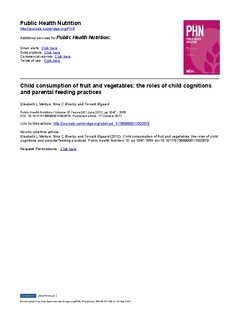| dc.contributor.author | Melbye, Elisabeth L. | |
| dc.contributor.author | Øverby, Nina Cecilie | |
| dc.contributor.author | Øgaard, Torvald | |
| dc.date.accessioned | 2013-01-31T12:25:31Z | |
| dc.date.available | 2013-01-31T12:25:31Z | |
| dc.date.issued | 2012 | |
| dc.identifier.citation | Melbye, E. L., Øverby, N. C., & Øgaard, T. (2012). Child consumption of fruit and vegetables: the roles of child cognitions and parental feeding practices. Public Health Nutrition, 15(6), 1047-1055. | no_NO |
| dc.identifier.issn | 1368-9800 | |
| dc.identifier.uri | http://hdl.handle.net/11250/139031 | |
| dc.description.abstract | Objective: To examine the roles of child cognitions and parental feeding practices in explaining child intentions and behaviour regarding fruit and vegetable consumption.
Design: Cross-sectional surveys among pre-adolescent children and their parents.
Setting: The child questionnaire included measures of fruit and vegetable consumption and cognitions regarding fruit and vegetable consumption as postulated by the Attitude-Social Influence-Self-Efficacy (ASE) model. The parent questionnaire included measures of parental feeding practices derived from the Comprehensive Feeding Practices Questionnaire (CFPQ).
Subjects: In total, 963 parents and 796 students in grades 5 and 6 from eighteen schools in the south-western part of Norway participated.
Results: A large portion of child intention to eat fruit and child fruit consumption was explained by child cognitions (29 % and 25 %, respectively). This also applied to child intention to eat vegetables and child vegetable consumption (42 % and 27 %, respectively). Parent-reported feeding practices added another 3 % to the variance explained for child intention to eat fruit and 4 % to the variance explained for child vegetable consumption.
Conclusions: The results from the present study supported the application of the ASE model for explaining the variance in child intentions to eat fruit and vegetables and in child consumption of fruit and vegetables. Furthermore, our findings indicated that some parental feeding practices do have an influence on child intentions and behaviour regarding fruit and vegetable consumption. However, the role of parental feeding practices, and the pathways between feeding practices and child eating intentions and behaviour, needs to be further investigated. | no_NO |
| dc.language.iso | eng | no_NO |
| dc.publisher | Cambridge University Press | no_NO |
| dc.subject | child cognitions | no_NO |
| dc.subject | fruit and vegetables | no_NO |
| dc.subject | parental feeding practices | no_NO |
| dc.title | Child consumption of fruit and vegetables : the roles of child cognitions and parental feeding practices | no_NO |
| dc.type | Journal article | no_NO |
| dc.type | Peer reviewed | no_NO |
| dc.rights.holder | © 2012 The Author(s) | |
| dc.subject.nsi | VDP::Medical disciplines: 700::Health sciences: 800::Nutrition: 811 | no_NO |
| dc.source.pagenumber | 1047-1055 | no_NO |
| dc.source.volume | 15 | no_NO |
| dc.source.journal | Public Health Nutrition | no_NO |
| dc.source.issue | 6 | no_NO |
| dc.identifier.doi | https://doi.org/10.1017/S1368980011002679 | |
